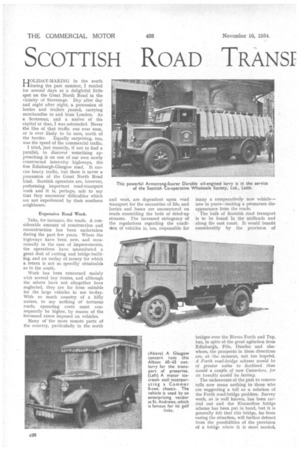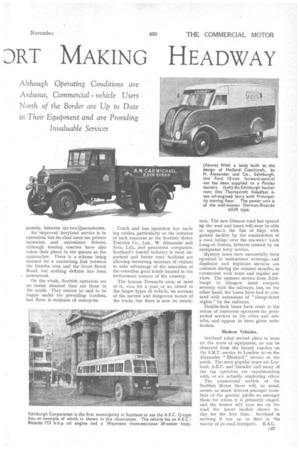SCOTTISH ROAD TRANST DWI MAKING HEADWAY
Page 92

Page 93

If you've noticed an error in this article please click here to report it so we can fix it.
Although Operating Conditions are Arduous, Commercial vehicle Users North of the Border are Up to Date in Their Equipment and are Providiftg
Invaluable Services
HOLIDAY-MAKING in the south 'during the past summer, I resided for several days at a delightful little spot on the Great North Road in the vicinity of Stevenage. Day after day and night after night, a procession of lorries and trailers passed, carrying merchandise to and from London. As a Scotsman, and a native of the capital at that, I was astounded. Never the like of that traffic +vas ever seen, or is ever likely to be seen, north of
the border. Equally surprising, too, was the speed of the commercial traffic.
I tried, just recently, if not to find a parallel, to discover something approaching it on one of our own newly constructed inter-city highways, the fine Edinburgh-Glasgow road. It carries heavy traffic, but there is never a procession of the Great North Road kind. Scottish operators are, however, performing important road-transport work and it is, perhaps, safe to say that they encounter difficulties which are not experienced by their southern neighbours.
Expensive Road Work.
Take, for instance, the roads. A considerable amount of construction and reconstruction has been undertaken during the past few years. Where the highways have been new, and occasionally in the case of improvements, the operations have necessitated a great deal of cutting and bridge-building, and an outlay of money for which a return is not so speedily obtainable as in the south.
Work has been concerned mainly with several key routes, and although the others have not altogether been neglected, they are far from suitable for the large vehicles in use to-day. With so much country of a hilly nature, to say nothing of tortuous roads, operating costs must consequently be higher, by reason of the increased stress imposed on vehicles.
Many of the more remote parts of the country, particularly in the north and west, are dependent upon road transport for the necessities of life, and lorries and buses are encountered on roads resembling the beds of dried-up streams. The increased stringency of the regulations regarding the condition of vehicles is, too, responsible for many a comparatively new vehicle— new in years—making a premature disappearance from the roads.
The bulk of Scottish road transport is to be found in the midlands and along the east coast. It would benefit considerably by the provision of
bridges over the Rivers Forth and Tay, but, in spite of the great agitation from Edinburgh, Fife, Dundee and elsewhere, the prospeots in these directions are, at the moment, not too hopeful. A Forth road-bridge scheme would be of greater value to Scotland than would a couple of new Cunarders, for its benefits would be lasting.
The endeavours of the past to remove tolls now mean nothing to those who are suggesting a toll as a solution of the Forth road-bridge problem. Survey work, as is well known, has been carried out and the Kincardine bridge scheme has been put in hand, but it is generally felt that this bridge, far.from easing the situation, will further detract from the possibilities of the provision of a bridge where it is most needed, namely, between the two Queensferrtes.
An improved ferryboat service is in operation, but its chief users are private motorists and ambulance drivers, although touring coaches have also taken their places in the queues at the approaches. There is a scheme being mooted for a connecting link between the Dundee area and the Great North Road, but nothing definite has been announced.
On the whole, Scottish operators are no better situated than are those in the south. They cannot be said to be happy under the prevailing burdens, but there is evidence of enterprise. Coach and bus operation has made big strides, particularly at the instance of such concerns as the Scottish Motor Traction Co., Ltd., W. Alexander and Sons, Ltd., arid associated companies. Scotland's tourist industry is most important and better road facilities are allowing increasing numbers of visitors to take advantage of the amenities of the countless good hotels located in the furthermost corners of the country.
The famous Trossachs area, or most of it, was, for a year, or so, closed to the larger types of vehicle, on account of the narrow and dangerous nature of the roads, but there is now no restric tion. The new Glencoe road has opened up the west and buses will soon be able to approach the Isle of Skye with greater facility by the construction of a road bridge over the sea-watttLoch Long at Domie, hitherto crossed by an antiquated terry service.
Mystery tours have successfully been operated in midsummer evenings, and duplicate and triplicate services are common during the summer months, in connection with tours and regular services. The summer service from Edinburgh to Glasgow must compete severely with the railways, but, on the other hand, the buses have had to contend with extensions of " cheap-ticket nights" by the railways.
Double-deck buses have come to the rescue of numerous operators for peakperiod services in the cities and suburbs, and appear to have given satisfaction.
Modern Vehicles.
Scotland takes second place to none on the score of equipment, as can be observed from the luxury coaches-on the S.M.T. service to Londtin or on the • Alexander Bluebird"service in the north. The most popular types are Leyland, A.E.C. and Daimler and many of the big operators are experimenting with, or are actually employing oilers.
The commercial section of the
Scottish Motor Show will, ustial, 'arouse as much interest 'amongst members of the general public as amongst those for whom it is primarily staged, and the former will 'soon See on the road the latest models shown today for the first time. Scotland is nothing if not up to date in the matter of its road transport. R.A.C.




















































































































































































